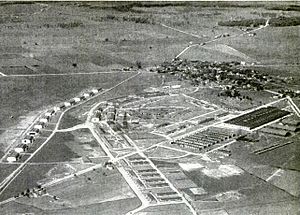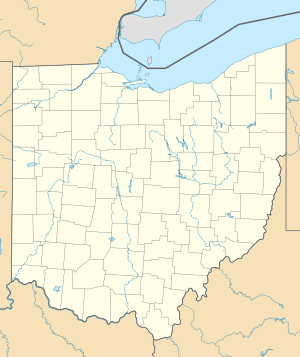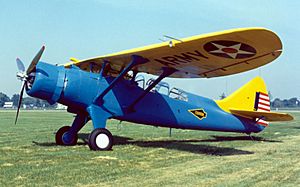Wilbur Wright Field facts for kids
Quick facts for kids Wilbur Wright Field |
|
|---|---|
| Riverside, Ohio | |

Wilbur Wright Field, c. 1920
|
|
| Coordinates | 39°46′46″N 84°6′16″W / 39.77944°N 84.10444°W |
| Type | Pilot training airfield |
| Site information | |
| Controlled by | Air Service, United States Army United States Army Air Forces |
| Condition | National Museum of the United States Air Force |
| Site history | |
| In use | 1917–1951 |
| Battles/wars | World War I World War II |
| Garrison information | |
| Garrison | Training Section, Air Service |
Wilbur Wright Field was an important military airfield and training center in Riverside, Ohio. It was first used during World War I to train pilots and mechanics. Later, it became a key location for testing new airplanes for the United States Army Air Corps and United States Army Air Forces. Today, this historic site is known as "Area B" of Wright-Patterson Air Force Base. It is also home to the National Museum of the United States Air Force, where you can see many amazing aircraft.
Contents
History of Wilbur Wright Field
Training Pilots in World War I
Wilbur Wright Field was created in 1917 during World War I. It covered about 2,075 acres of land next to the Mad River. This area included the famous Wright Brothers' Huffman Prairie Flying Field, where they tested their early planes. The Army rented this land to set up a Signal Corps Aviation School.
The main goal of the field was to train combat pilots for the war in France. It also had schools for aviation mechanics and armorers (people who worked with weapons on planes). In 1918, a pilot named Lt. Frank Stuart Patterson died during a test flight at the airfield. He was testing a machine gun system when his plane broke apart.
After World War I ended, the training school at Wilbur Wright Field closed down.
Between the World Wars
After World War I, Wilbur Wright Field and the nearby Fairfield Aviation General Supply Depot merged. This new combined area was called the Fairfield Air Depot.
In 1923, some amazing flight records were set from Wilbur Wright Field. A Fokker T-2 airplane flew a 50-kilometer course, setting new records for speed, distance, and endurance. The field also started using a special radio beacon system to help pilots navigate. This system used Morse code signals to guide planes.
In 1926, the Field Service Section at Wilbur Wright Field joined with McCook Field's Engineering Division. They formed a new group called the Materiel Division. This group moved to Wright Field when McCook Field closed in 1927. The Fairfield Air Depot continued to be active until 1946.
New Names and Roles
In 1924, the city of Dayton bought 4,500 acres of the Fairfield Air Depot. They also bought an extra 750 acres nearby. This larger combined area was named Wright Field. It was named to honor both of the Wright Brothers.
A new base with permanent brick buildings was built to replace McCook Field. It officially opened on October 12, 1927. Wright Field became the main center for research and development for the Air Corps. This meant they would test and improve new aircraft and technologies here.
Later, on July 6, 1931, the eastern part of Wright Field was given a new name: Patterson Field. This area included the old Fairfield Air Depot and Huffman Prairie. Patterson Field became a key place for logistics, which means managing supplies and equipment for the Air Corps. Wright Field kept the western land and continued its research and development work.
Important Events Before World War II
Before the attack on Pearl Harbor that started World War II for the U.S., both Wright Field and Patterson Field were busy with many aviation tests and achievements:
- In May 1932, pilots at Patterson Field practiced "blind landings." This meant landing planes using only instruments, which was very important for flying in bad weather.
- In 1935, new automatic radio navigation equipment was tested at Wright Field. This helped planes fly themselves using radio signals.
- On October 30, 1935, the first "Flying Fortress" prototype, the Boeing 299, crashed during testing at Wright Field. Sadly, this accident killed the chief of the Flying Division and the Boeing test pilot.
- In December 1936, the XB-15, which was the largest bomber plane at the time, arrived at Wright Field for testing.
- In April 1939, a school for autogiro (a type of aircraft that looks like a helicopter and airplane combined) training and maintenance opened at Patterson Field.
- In July 1939, a Boeing B-15 plane from Wright Field set a world record. It carried over 15 tons of weight to a height of 8,200 feet.
- In June 1940, construction began at Wright Field to prepare for World War II. New concrete runways were built, which were finished by 1944.
Becoming Wright-Patterson Air Force Base
On December 15, 1945, several military airfields merged together. These included Wright Field, Patterson Field, Dayton Army Air Field, and Clinton County AAF. They formed a new base called the Army Air Forces Technical Base.
After the USAF was created, the base was renamed the Air Force Technical Base in December 1947. Then, in January 1948, it became what we know today as Wright-Patterson Air Force Base. The original Wright Field is now called Area B of this large base.
Images for kids





